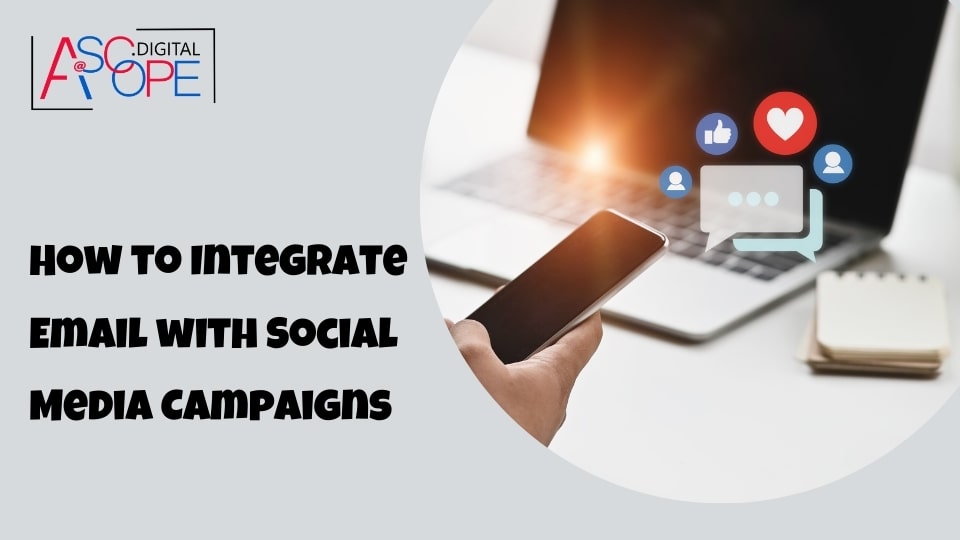In the modern digital marketing landscape, integrating email with social media campaigns has become essential for maximizing reach, engagement, and conversions. By leveraging the strengths of both channels, businesses can create a cohesive and powerful marketing strategy that drives traffic and boosts sales. This article explores various strategies and tools to effectively integrate email marketing with social media campaigns.
Understanding the Importance of Integration
Email marketing and social media are two of the most potent tools in a marketer’s arsenal. Each has its unique advantages—email provides a direct and personal communication channel, while social media offers a platform for broad engagement and viral content sharing. Integrating these channels allows marketers to create synergistic campaigns that amplify their messages and reach a wider audience.
Building a Unified Marketing Strategy
To successfully integrate email marketing with social media campaigns, it’s crucial to develop a unified marketing strategy. This involves aligning your goals, messaging, and branding across both channels. Consistency is key—your email subscribers should recognize your brand’s voice and visuals on social media, and vice versa.
- Align Your Goals: Start by identifying your marketing goals and how email and social media can help achieve them. Whether you’re looking to increase brand awareness, drive website traffic, or boost sales, having clear objectives will guide your integration efforts.
- Consistent Messaging and Branding: Ensure that your messaging and branding are consistent across both channels. This includes using similar color schemes, fonts, and logos, as well as maintaining a consistent tone of voice. This helps create a seamless experience for your audience and reinforces brand recognition.
Leveraging Social Media to Grow Your Email List

One of the simplest ways to integrate email with social media is by using social media platforms to grow your email list. Here are some effective strategies:
- Promote Your Email Sign-Up Form: Share your email sign-up form on your social media profiles and encourage your followers to subscribe. Use compelling calls-to-action (CTAs) and highlight the benefits of joining your email list, such as exclusive content, discounts, or early access to new products.
- Run Social Media Contests: Contests and giveaways are excellent ways to attract new subscribers. Require participants to provide their email addresses to enter, and promote the contest on your social media channels. This not only grows your email list but also boosts engagement on social media.
- Utilize Lead Generation Ads: Platforms like Facebook and Instagram offer lead generation ads that allow users to sign up for your email list directly from the ad. These ads are highly effective because they simplify the sign-up process, making it easy for users to subscribe without leaving the platform.
Integrating Email with Social Media Content
Integrating email with social media content involves sharing and repurposing content across both channels. This not only maximizes your content’s reach but also ensures a consistent message across your marketing efforts.
- Share Email Content on Social Media: Repurpose your email content by sharing it on your social media profiles. This could include snippets from your newsletter, blog posts, product announcements, or special promotions. Include a link to your email sign-up form to encourage social media followers to subscribe.
- Encourage Social Sharing in Emails: Include social sharing buttons in your emails, making it easy for subscribers to share your content on their social media profiles. This can help increase the reach of your emails and attract new subscribers.
- Highlight Social Media Content in Emails: Feature your top social media posts in your emails to drive traffic to your social profiles. This could include popular posts, user-generated content, or upcoming events. Encourage subscribers to follow you on social media for more updates.
Utilizing Email and Social Media Analytics

Data and analytics play a crucial role in the successful integration of email and social media campaigns. By analyzing the performance of both channels, you can gain insights into what works and what doesn’t, and make data-driven decisions to optimize your strategy.
- Track Engagement Metrics: Use analytics tools to track key engagement metrics for both email and social media, such as open rates, click-through rates, likes, shares, and comments. Comparing these metrics can help you understand which content resonates most with your audience and inform your future campaigns.
- Segment Your Audience: Segment your email list based on social media engagement and vice versa. For example, you can create a segment of email subscribers who frequently engage with your social media posts and send them personalized content that aligns with their interests.
- A/B Testing: Conduct A/B tests to compare the effectiveness of different integration strategies. For instance, you can test different types of social media content in your emails to see which generates the most clicks, or experiment with various CTAs to find the most effective approach.
Tools for Integrating Email with Social Media
Several tools can help streamline the integration of email marketing and social media campaigns. These tools offer various features, such as social media scheduling, email automation, and analytics, to simplify the process and enhance your marketing efforts.
- Mailchimp: Mailchimp is a popular email marketing platform that offers seamless integration with social media. You can create and schedule social media posts directly from the platform, as well as track the performance of your email and social media campaigns in one place.
- Hootsuite: Hootsuite is a comprehensive social media management tool that allows you to schedule and manage your social media posts, track engagement metrics, and analyze the performance of your campaigns. It also integrates with various email marketing platforms, making it easy to coordinate your efforts.
- HubSpot: HubSpot is an all-in-one marketing platform that offers robust tools for email marketing, social media management, and analytics. With HubSpot, you can create integrated campaigns, track performance, and gain valuable insights into your audience’s behavior.
- Buffer: Buffer is a social media scheduling tool that allows you to plan and schedule your posts in advance. It also offers analytics features to track engagement and measure the success of your campaigns. Buffer integrates with several email marketing platforms, making it easy to coordinate your efforts.
Case Studies: Successful Integration Examples
To illustrate the effectiveness of integrating email with social media campaigns, let’s look at a few case studies of brands that have successfully implemented this strategy.
- Starbucks: Starbucks has effectively integrated its email marketing and social media campaigns to create a cohesive and engaging experience for its customers. By promoting its email sign-up form on social media and sharing exclusive offers and content across both channels, Starbucks has been able to grow its email list and drive traffic to its social profiles.
- Airbnb: Airbnb uses email and social media to promote its listings and engage with its audience. By featuring user-generated content from social media in its emails and encouraging subscribers to follow its social profiles for travel inspiration and updates, Airbnb has been able to create a strong and loyal community of travelers.
- Nike: Nike leverages the power of email and social media to promote its products and campaigns. By sharing email content on social media and encouraging subscribers to engage with its posts, Nike has been able to increase brand awareness, drive traffic to its website, and boost sales.
Best Practices for Integration

To ensure the successful integration of email and social media campaigns, it’s important to follow best practices that maximize the effectiveness of your efforts.
- Consistent Branding: Maintain consistent branding across both channels to create a seamless experience for your audience. This includes using the same logos, color schemes, fonts, and tone of voice.
- Compelling CTAs: Use compelling calls-to-action in both your emails and social media posts to encourage engagement and drive conversions. Whether you’re promoting a product, sharing a blog post, or encouraging sign-ups, make sure your CTAs are clear and persuasive.
- Engage with Your Audience: Actively engage with your audience on both channels by responding to comments, sharing user-generated content, and asking for feedback. This helps build a strong and loyal community around your brand.
- Measure and Optimize: Continuously measure the performance of your campaigns and use the insights to optimize your strategy. This includes tracking engagement metrics, conducting A/B tests, and analyzing the results to make data-driven decisions.
Overcoming Common Challenges
While integrating email with social media campaigns offers numerous benefits, it also comes with its challenges. Here are some common challenges and how to overcome them:
- Maintaining Consistency: Keeping your branding and messaging consistent across both channels can be challenging, especially if you have a large team. To overcome this, create a brand style guide that outlines your visual and messaging guidelines, and ensure that all team members are familiar with it.
- Managing Multiple Platforms: Managing multiple platforms can be time-consuming and complex. Use marketing automation tools to streamline the process and save time. These tools allow you to schedule posts, track engagement, and analyze performance from a single dashboard.
- Engaging Your Audience: Keeping your audience engaged on both channels requires ongoing effort and creativity. Use a mix of content types, such as blog posts, videos, infographics, and user-generated content, to keep your audience interested and engaged.
- Measuring ROI: Measuring the ROI of integrated campaigns can be challenging, especially if you’re using multiple tools and platforms. Use analytics tools that offer comprehensive reporting and track key metrics, such as conversion rates, to measure the success of your campaigns.
Conclusion
Integrating email marketing with social media campaigns is a powerful strategy that can significantly enhance your marketing efforts. By leveraging the strengths of both channels, you can create cohesive and engaging campaigns that drive traffic, boost sales, and build a loyal community around your brand. By following the strategies and best practices outlined in this article, you’ll be well on your way to successfully integrating your email and social media marketing efforts.
Thus, improving traffic and sales for your website. Read more on the other reasons why your website isn’t getting traffic. By understanding and implementing these integration strategies, you’ll be able to maximize the effectiveness of your marketing campaigns and achieve your business goals


